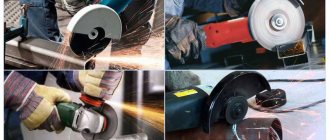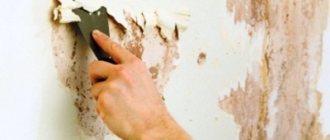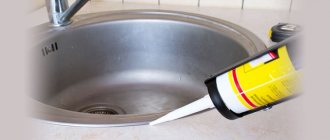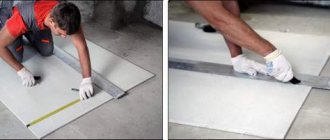The ceiling is finished to give the room additional expressiveness. When performing these works, various devices are used to decorate the floor slab. Such operations include installing plasterboard boxes, plastering and painting the ceiling, as well as fixing additional decorative elements. Parts of this category include ceiling plinths, which are glued along the lines where the floor slab meets the vertical structures of the room.
Ceiling plinth in the interior
Why do you need a plinth on the ceiling?
Ceiling plinth is not just a decorative element of finishing the ceiling. It takes on several important functions:
- Expressiveness of the design solution for the style of the room when performing finishing work.
Ceiling with plinth
- Masking defects in the joint between the ceiling and adjacent wall structures.
- Hidden cable routing, for example, when installing CCTV cameras or fire alarms.
Laying cables in the ceiling plinth
In almost any interior where a ceiling plinth is not installed, the curvature of the joints of structural elements is noticeable, since it is almost impossible to achieve an ideal mating line in paint of different shades.
Scope of use and additional information
The framing corner is made by hot bending a PVC sheet. The decorative element allows you to choose colors that will suit any interior. Application area:
- Window slope inside a house or apartment.
- As an external material to protect external or internal corners.
- Door or arched opening.
- To protect the corner of the wall when decorating with wallpaper.
- Protection of corners when finishing with plastic in the bathroom.
- Draping the joint when decorating external siding.
The plastic element is a good protector from mechanical stress, but, like any material, it has advantages and disadvantages:
- The installed corner is used as a finishing seam at the junction of finishing materials.
- Long service life - up to 25 years.
- Installation is carried out independently; you can glue the corner without prior preparation.
- The plastic element is easy to trim and comes in different colors.
- Acceptable price.
Why are plastic corners needed on slopes
? Among the disadvantages, the following turned out to be significant:
- Plastic is a fragile material, so it must be cut with special tools - cracks may appear.
- The flammable finishing element does not tolerate high temperatures.
What characteristics should you pay attention to when choosing
In construction markets or in specialized retail outlets you can find hundreds of options for ceiling plinths from various competing manufacturers. When choosing and purchasing this finishing element, you should pay attention to the following characteristics of the product:
- Ceiling plinth material:
- Polyurethane - PVC products, characterized by increased flexibility and strength.
Polyurethane ceiling plinth
- Expanded polystyrene - characterized by low weight and simplicity of design.
Expanded polystyrene ceiling plinth.
- Plastic - any pattern and bas-relief can be formed on the surface.
Plastic ceiling plinth
- Wooden ones are highly environmentally friendly and look ideal in country or loft style interiors.
Wooden ceiling plinth
- Gypsum - form an inextricable structure with the ceiling plaster.
Gypsum ceiling plinth
- Based on surface shape, there are 4 main types of products:
- With a convex profile.
Element with a convex surface
- With a concave surface.
Element with concave surface
- With curly cutting.
Element with curly cutting
- With a bas-relief image - suitable for interiors in antique or oriental styles.
Element with bas-relief
- In terms of dimensions - the standard length of ceiling plinths varies from 2 to 3 meters. When installed on the ceiling, the elements are joined together, followed by sanding the seam. The width of interior parts can be from 15 – 20 mm to 200 – 250 mm.
- Symmetrical or asymmetrical.
Symmetrical product
Asymmetrical product
- According to the finishing method, the surfaces of plinths for ceilings are produced in a rough version - intended for final finishing - putty and painting, as well as finished products covered with a layer of fine finishing, with a glossy or matte texture.
Depending on the material from which the products are made, there are several types of trimming for arranging elements along the length of the room and for joining them in the corners of the room.
Preparing for work
Before attaching the plastic corner to the work areas, they are freed from dust particles and construction contaminants. If there are protruding parts, remove and level the surface, otherwise the profile will lie crooked.
For work you need to prepare the following devices and tools:
- glue gun;
- roulette;
- construction knife;
- masking tape;
- square, preferably made of metal;
- miter box (you can do without it).
Clean and dry surfaces to be bonded are degreased with any solvent.
It is important to correctly measure the window slopes and prepare the finishing material. The basis should be one of the sides of the corner, which is cut off from the outside with a margin of 20 mm, this applies to the vertical, upper parts, taking into account both sides. All parts must consist of one whole segment; connections are not allowed.
External corners are joined in the following ways:
- overlapping each other, then leveled with putty to match the color of the plastic;
- cutting at an angle of 45°;
- by cutting one of the allowances to the base (the top one remains with a margin, and the vertical ones are cut flush).
It is advisable to check the accuracy of the cut elements by joining the parts. Cut with a special knife, otherwise the material may be damaged.
Tools needed to trim ceiling skirting boards
To accurately cut decorative ceiling elements at 90, 45 degrees, or to form an arbitrary angle, you need to have a certain set of tools on hand:
- Tape measure for measuring the cutting line along the length of the plinth.
Roulette
- Ruler or caliper, if necessary, measure an angle of 45 or 30 degrees, using the rules of geometry.
Calipers
- A pencil with a soft lead for marking the element after taking measurements.
Construction pencil
- A miter box is a special plastic slipway that can be bought at any hardware store. Designed for precise cutting of linear elements in an orthogonal direction or at an angle of 45 degrees.
Miter box
- A hacksaw with a wide blade and fine teeth, as a rule, goes on sale along with a miter box.
Hacksaw for miter box
- File for rough grinding of polymer or wooden materials after cutting.
Wood file
- A grinding disc for a drill if it is necessary to precisely grind the end of the finished product after cutting.
Grinding disc for drill
- Hand-held electric drill for installing the sanding disc.
Hand electric drill
- Sandpaper with a fine abrasive to bring the end of the product to perfection after cutting.
Sandpaper
- When working with solid wooden baseboards, it is recommended to rent or purchase a cross-cutting machine. It is a special type of circular saw with an adjustable bed. A protractor on the metal base of the tool, complete with fixing screws, allows you to secure the working blade of a circular saw at any angle.
Cross-cutting machine
- A construction folding knife with a retractable blade - for the need to refine the shaped edges of foam or PVC skirting boards.
Construction knife
To achieve the desired result, all specified tools must be available, in good working order, well sharpened and ready for work.
Comparing types and sizes
Framing always begins with choosing the type and size of the plastic element. The table shows data about plastic corners, their sizes and types for slopes:
| View: | Size: |
| Equilateral: | 20*20 – 50*50 mm, standard length, attached to give strength. |
| Not equilateral: | 5*17 and 20*25 mm, lining of arch openings, usually installed on curved compositions. |
| T-shape: | 12*10, 18*10, 20*10, 22*10 mm, installation is necessary to hide the seams. |
| Removable (with latch): | Standard, the shelf bends for dismantling. Easy to install, no need to stick. |
During installation, it is necessary to cut the corner to form the desired length. A sharp utility knife will help with this. If you need to cut at a clear angle, you will need to prepare a miter box and a hacksaw.
Important! The colored plastic corner for internal slopes is available in lengths of 2.6 m, 2.7 m, 2.8 m, 3.0 m.
How to glue plastic corners onto slopes (video)
Cut without a miter box
If you don’t have a miter box on hand, you can also easily cut the ceiling plinth at an angle of 45 degrees using two possible methods:
- Application of a cross-cutting machine with a circular saw and an electric drive:
- To correctly cut a pre-marked element, you only need to place it on the frame of the power tool and set the position of the protractor at the desired angle.
Cutting the element on a cross-cutting machine
- Next, the installation is connected to the network, the circular saw blade begins to rotate at high frequency.
- The master gradually lowers the handle of the tool along with the disk onto the plinth, and the sharp teeth instantly cut a part from any material.
Working of a cross-cutting machine
- The cut can also be made on a table using a regular hacksaw:
- To achieve the desired result, you just need to mark the element correctly.
- It is known that in a right triangle, acute angles of 45 degrees are formed when the legs are equal.
Marking an element manually
- This means that to mark such a diagonal on the surface of the plinth, you need to measure a distance equal to the thickness of the element with a ruler or caliper.
- Next, two points on the plinth are connected diagonally, and this line will ensure cutting at the desired angle for subsequent joining of the material.
- The cut is made with a fine-tooth hacksaw on a smooth, hard surface where you can safely place the entire plinth.
Cutting the baseboard without a miter box
If, after cutting, the orthogonal parts do not fit well with each other due to small errors in cutting and marking, the edges are processed with a grinding disc or finished “by eye” with a construction knife.
How can I cut a plastic corner evenly? (Page 1 of 2)
To post a reply you must log in or register.
Messages [ 1 to 25 of 30 ] 955 [Closed]
1 Topic from Kompozit 04/28/2015 17:39:09 (6 years 4 months ago)
- Composite
- Engineer, Ph.D.
- Topic author
- Inactive
- From: Krasnoarmeysky 57
- Experience: 11 years 5 months
- Messages: 4 319
- Reputation: [258 | 1 ]
Topic: How can I cut a plastic corner evenly?
Hi all!
You need to shred a 10*15 plastic corner into 150 mm pieces (cut at 90 degrees). I'm still cutting with metal scissors. But at the end (in the corner itself) it often breaks off, and then you have to cut/finish it with a knife. Are there any special scissors for plastic? A grinder is not an option, the corner is thin.
2 Reply from antooon 04/28/2015 17:40:51 (6 years 4 months ago)
- antooon
- bom bom
- Inactive
- From: from there
- Experience: 9 years 8 months
- Messages: 10 078
- Reputation: [ 185 | 5 ]
Re: How can I cut a plastic corner evenly?
Jedi laser sword
but there doesn’t seem to be anything like that on the topic) I myself cut in the same way with metal scissors)
3 Reply from cjserafim 04/28/2015 17:43:44 (6 years 4 months ago)
- cjserafim
- Participant
- Inactive
- Experience: 9 years 7 months
- Messages: 100
- Reputation: [ 4 | 0 ]
Re: How can I cut a plastic corner evenly?
A stationery knife? Prada long
4 Reply from TeleSTROKA 04/28/2015 17:48:58 (6 years 4 months ago)
- TeleSTROKA
- goat naka
- Inactive
- Experience: 7 years 7 months
- Messages: 2 784
- Reputation: [ 44 | 0 ]
Re: How can I cut a plastic corner evenly?
Try a metal saw. It never worked with scissors.
5 Reply from antooon 04/28/2015 17:51:36 (6 years 4 months ago)
- antooon
- bom bom
- Inactive
- From: from there
- Experience: 9 years 8 months
- Messages: 10 078
- Reputation: [ 185 | 5 ]
Re: How can I cut a plastic corner evenly?
Try a metal saw. It never worked with scissors.
there will be serifs. scissors smoother
6 Reply from Frances 04/28/2015 17:52:49 (6 years 4 months ago)
- Francis
- Participant
- Inactive
- From: on the other side
- Experience: 10 years 6 months
- Messages: 19 803
- Reputation: [ 276 | 8 ]
Re: How can I cut a plastic corner evenly?
Have you tried a hand jigsaw?
7 Reply from TeleSTROKA 04/28/2015 17:53:16 (6 years 4 months ago)
- TeleSTROKA
- goat naka
- Inactive
- Experience: 7 years 7 months
- Messages: 2 784
- Reputation: [ 44 | 0 ]
Re: How can I cut a plastic corner evenly?
there will be serifs. scissors smoother
You can smooth them out with sandpaper. But yes, they will.
Edited by TeleSTROKA (04/28/2015 05:53:49 PM, 6 years 4 months ago)
8 Reply from Alex Potter 04/28/2015 17:54:34 (6 years 4 months ago)
- Alex Potter
- Participant
- Inactive
- From: Popova/Baltiyskaya/Shumakova
- Experience: 7 years 10 months
- Messages: 4 996
- Reputation: [ 127 | 2]
Re: How can I cut a plastic corner evenly?
maybe try a hot cutter? which cuts, for example, foam plastic with a hot string. I remember my dad cut out the letters at one time and made up an honor board at work
9 Reply from Barnauletz 04/28/2015 17:58:12 (6 years 4 months ago)
- Barnauletz
- Participant
- Inactive
- Experience: 8 years 7 months
- Messages: 10 021
- Reputation: [325 | 2]
Re: How can I cut a plastic corner evenly?
10 Reply from Matvey 04/28/2015 18:01:45 (6 years 4 months ago)
- Matvey
- Participant
- Inactive
- From: Shumakova 50
- Experience: 8 years 3 months
- Messages: 7 396
How to join a ceiling plinth in a corner
When installing ceiling plinths, beginners make the main mistake - after cutting one element, they immediately fix it to the ceiling, and then try to fit the orthogonal part under the already glued plinth. To achieve a decent appearance of the ceiling decor, you must follow the recommendations of professional craftsmen:
- Before fixing mutually perpendicular parts in the corners of the room, you should cut out both elements and attempt to join them on the floor.
Preliminary docking
- If, when joining the baseboards, a concave gap is formed, or, conversely, a convexity, the end is finished by grinding or manual trimming with a construction knife.
Docking gap
- For the convenience of the device and to achieve a better visual effect, many manufacturers supply ready-made corners for sale. Such extensions have the same profile shape as the linear elements and are a standard corner joined at an angle of 90 degrees. The disadvantages of such parts are that the internal corners of the room must be strictly orthogonal, since it will no longer be possible to fit such a part in place.
Finished corner of the ceiling plinth
- When fixing the plinth, even if the end surface is perfected and the linear elements fit together without a gap, you should try on both parts on the ceiling. In most cases, millimeter discrepancies occur, especially when joining external corners.
Trying on parts on the ceiling
If you follow all the recommendations, the decorative structure will look flawless, without visible surface defects and gaps in the joining area.
DIY installation of a decorative PVC corner
Plastic (PVC) corners
They are very widely used in interior decoration; they are installed on the slopes of plastic windows, they frame the outer corners of walls and the slopes of doorways. In this article we will take a detailed look at the process of installing a PVC corner on the slope of a plastic window, and also consider how to make a neat joint between two corners.
Step 1.
We make markings. We need to attach the PVC corner to the slope and make a mark along the edge of the vertical slope:
Minimum length
the applied corner (L) must be greater than the height of the slope (a), by the width of the corner (b), taking into account a small margin (c):
For example, if the height of the slope is a = 1500 mm, and the width of the corner b = 30 mm, then the length of the corner must be at least
a + b + c = 1500 + 30 + 15 = 1545 mm.
Step 2.
We make a cutout on the PVC corner, removing one edge, as shown in the photo below:
We apply the corner to the slope:
The corner fits perfectly, you can proceed to the next step.
Step 3.
The plastic corner is glued only to the slope, this is enough for fixation, so we apply glue only to one of the edges.
“How to glue the PVC corner?”
As glue you can use “Moment Montazh”, “QUELYD Masterfix” and their analogues. It is not recommended to use super glue, as it will be almost impossible to correct mistakes.
Glue is applied to the inner surface of the corner either pointwise or in a thin strip:
We fix the PVC corner with masking tape (while the glue dries):
Step 4.
Repeat step 1-3 for the right slope:
Step 5.
We mount the corner on a horizontal slope. The length of the corner is taken with the same margin as for the vertical one, but taking into account two sides. Markings are also made, and then cuts are made and the corner is glued to the slope:
Step 6.
Mark the cutting location. The corners will be joined at an angle of 45°:
Step 7
Carefully cut two corners at once. It is very important that the knife is sharp:
Step 8
Seal the joint between the corners with white acrylic sealant. After the glue has dried, remove the masking tape. The installation of the PVC corner is completed.
Features of cutting corners on ceiling plinths
When cutting linear elements of ceiling plinth, there are some features and tricks that are well known to professionals. To obtain an impeccable decor on the ceiling, you must consider the following nuances:
- When purchasing parts, you should check the transverse dimensions of each product, since even millimeter deviations from the standard will be noticeable when joining at an internal or external angle.
- If you don’t have a miter box on hand, but the home craftsman needs to cut at an angle of 45 degrees, you can make a template yourself by simply drawing a square with diagonals on a checkered notebook sheet.
DIY miter box
- If during the joining process a small gap cannot be removed by sanding, it can be masked later using ordinary putty, which is applied to the ceiling.
Ceiling plinth putty
- When cutting using a miter box, you should press the plinth against one of the walls of the template.
Cutting work requires the craftsman to pay increased attention to details and nuances, since a mistake can lead to irreversible consequences and unjustified costs for the purchase of new decorative elements.
Surface preparation
In order to carry out the procedure for preparing surfaces for installation of corners, it is necessary to consistently carry out a number of small but important measures. All of them should be carried out in strict sequence and without deviations from the plan, otherwise failure to comply with these recommendations may lead to undesirable results.
You will most likely have to redo everything again. And this will require additional time, effort and finances.
- Make sure the surface is free of any protruding parts. Any nails, wallpaper and all surface irregularities should not bother you. If the wall is uneven, then it is worth leveling it with plaster.
- If there is wallpaper pasted on the corner of the wall, then it must be cut off. Otherwise, you will glue the corner not to the wall, but to this wallpaper, and there can be no talk about the reliability of installation.
- The surfaces need to be degreased. Use a weak solvent or alcohol. The corners are glued to the slopes already prepared for this.
At this point, surface preparation can be considered complete and you can proceed further.
Caring for the ceiling plinth after installation in the design position
When the plinth is cut and glued to the ceiling, before applying the finishing coating, you must follow some recommendations for caring for the decorative element:
- The surface of the product must be smooth, without mechanical damage along the entire length.
- When orthogonal or diagonal seams are formed after fixing the elements, it is necessary to grind them using fine abrasives.
Visible seams after joining parts on the ceiling
- If gaps form during fixation, they should be masked under a layer of putty.
- Before applying the final coat of paint, the putty surface should be sanded with fine sandpaper, removed from dust, and then coated with a layer of penetrating primer.
Painting the baseboard
With proper care, the finishing layer of paint fits perfectly onto the decorative structure, giving it a finished look. This will provide special expressiveness to a classic or modern interior, made in accordance with the designer’s intentions.
Arch finishing
The design of the arch often becomes a problem. In general, there are not so few external corners in the apartment, but on the arch there are certainly some. And in the aisle they very often get touched. Either furniture, or other cargo, or simply an inhabitant who did not fit into the gap. And if there are no questions with the straight part, then the round part may be a problem.
And not only in the doorway can there be an arched vault
In general, you can use universal corners for the arch. They are flexible, which is very comfortable. There are flexible, non-universal ones - plastic, made from a special polymer with high elasticity.
But in general, corners with different shelf widths are used to design arches. They are even called arched. They have one shelf of 10 mm (external) and the second - internal - 30 mm or more. They simply bend. You can’t twist it into a donut, but it’s not difficult to get at least some curvature in the arc. You will only need to use a secure hold while the glue dries.
If you want to bend an ordinary corner, you can do this by heating the plastic. For this work you need a hair dryer. Ordinary one - for hair - will not work, because its temperature is very low. We also need a template according to which we will bend the plastic corner. Take a piece of fiberboard, tighten the screws or drive in nails, forming the profile that you require.
This way you can decorate the corners of the arch with protective corners
They start bending from the middle. Warm up the area, constantly pressing on the middle, and using a hairdryer, moving from the center to the edges. So you need to bring the corner to a suitable curvature and leave it in this position to cool. To prevent it from straightening out, along with a number of screws, holes are made for the 2nd row. The distance between the rows is equal to the width of the corner shelf. After the plastic has bent, insert and tighten the screws a little. After the plastic has cooled, remove them.
Briefly about the main thing.
Ceiling plinth is an important element of finishing the ceiling surface, which simultaneously plays a decorative role and masks visible defects in the interface between the floor slab and the vertical structures of the room. This element is made of polystyrene foam, PVC, wood or gypsum. When cutting, you will need a special portable bench - a miter box, or a cross-cutting machine. In the absence of such a tool, a miter box template with diagonals at 45 degrees can be drawn on paper.
Using an electric saw
The miter saw cuts at an angle with high precision.
To perfectly cut a ceiling plinth, it is best to use an electric miter saw, where you can set it in any direction and cut off the desired slope as accurately and accurately as possible.
It doesn't require much effort. You just need to set the desired parameters and lower the saw blade onto the surface to be cut, be it wood or plastic. However, you can cut down the ceiling plinth using cheaper tools.
Adviсe
Some useful tips to help you with your work:
- Before you start making final cuts, it is worth practicing on a small section.
- The baguette should be cut from the front side, then the unevenness of the cut will remain on the back side.
- The cut can be carefully trimmed with a knife or sandpaper.
- The plinth should be cut on a hard, flat surface.
- If you use a miter box, for convenience it can be secured to the work surface with self-tapping screws.
- If the result is unsatisfactory and gaps at the joints are still visible, they can be carefully puttied.
If the corners in the room being renovated are even, you can buy ready-made corners for the chosen type of baguette and completely avoid the stage of cutting corners.
Did you like the article? Subscribe to the channel to stay up to date with the most interesting materials
Conclusion
All three methods I described work; the choice depends on what tool you have and what your professional skills are. If after watching the video you still have questions, welcome to the comments, I’ll help in any way I can.
If you are not confident in your abilities, then for both floor and ceiling plinths there are joining elements that allow you to do without trimming.











